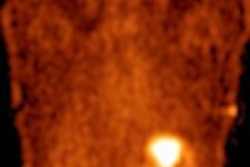The International Workshop Criteria (IWC) is the most widely used staging mechanism for response assessment of non-Hodgkin's lymphoma (NHL). The IWC criteria are primarily based on CT imaging, as well as bone marrow biopsy and biochemical information, for assigning a patient's final response designation. However, a recent multinational study available online prior to publication in the Journal of Clinical Oncology provides compelling evidence that integration of PET into the IWC demonstrates a more accurate response assessment for NHL.
"The dominant role of CT in response assessment of NHLs warrants critical assessment considering that in perhaps no other cancer type, with the exception of Hodgkin's lymphoma, has there been such a compelling documentation of the limitations of CT in assessment of response to therapy," the authors wrote.
"These limitations are primarily due to the inability of CT to differentiate between viable tumor, necrosis, or fibrosis in residual mass(es) in patients with otherwise clinical complete response (CR), which occurs in approximately 40% of NHL patients treated with chemotherapy and/or radiation," they stated.
The researchers evaluated 54 patients (mean age 58) over an eight-year period with aggressive NHL from the University of Iowa in Iowa City; the Mayo Clinic in Rochester, MN; and the University of Ulm in Germany. The patients underwent FDG-PET (GE Healthcare and Siemens Medical Solutions scanners) and CT imaging one to 16 weeks after four to eight cycles of chemotherapy.
The patients fasted for a minimum of four hours and were administered 10-15 mCi of 18F-FDG one hour before their PET scan. Two-dimensional PET images were acquired from the patient's earlobes to proximal thighs with emission scans of five minutes per bed position, followed by transmission scans of three minutes per bed position.
"Baseline and follow-up helical CT scans of neck, chest, abdomen, and pelvis were obtained using intravenous contrast," the authors wrote.
The PET scans were interpreted by an experienced nuclear medicine physician and the CT scans by an experienced radiologist who were blinded to the patient outcome, according to the authors. The images were then assigned an IWC designation (complete response, CR; complete unconfirmed response, CRu; partial response, PR; stable disease, SD; or progressive disease, PD) on the basis of the physician's diagnosis.
According to the researchers, 33 patients had concordant designations and 21 had discordant designations. The team observed that the most pronounced discordance was observed in the CRu by IWC designation with CT, in which all seven CRu designations were reclassified as CR (n = 5) or PR (n = 2) by the use of PET with the IWC.
"Given that five of the seven patients were completely PET-negative and none had bone marrow involvement with NHL at baseline (a post-therapy bone marrow biopsy was therefore not required according to the recommendations of the International Workshop), the patients were appropriately reclassified as CR by IWC+PET," the authors wrote.
They noted that the other major discordance in the IWC designation utilizing only CT imaging was found in the PR category. Ten of 19 patients, 52.6%, were reclassified as CR by PET.
"All but one patient who experienced relapse remain without evidence of disease progression at 26.4 to 38 months (median 33.8 months) of follow-up; the estimated three-year progression-free survival rate (PFS) in this group is 88.9%," the authors stated.
The researchers believe that the utilization of PET/CT, which was not used in their study, holds even greater promise for staging NHL.
"Given that our data suggest that PET combined with visual correlations with a contrast-enhanced CT better predicts PFS compared with CT alone in this setting, it is likely that a truly integrated approach of fused PET and CT images will yield similar or superior results," they wrote.
The research group's work, although not yet in print, has already had an impact on NHL staging criteria. In an e-mail to AuntMinnie.com, study author Dr. Malik Juweid from the University of Iowa wrote that the team's work on IWC+PET is being considered as a new standard.
"Based on my article on integrated IWC+PET-based response assessment in aggressive lymphoma, an international lymphoma conference in Lugano, Switzerland, convened in June 2005 will now formally integrate PET into the internationally employed response criteria for lymphoma, adopting nearly all criteria proposed in my paper with some, probably minor, modifications," he wrote.
By Jonathan S. Batchelor
AuntMinnie.com staff writer
June 10, 2005
Related Reading
FDG-PET/CT tops other technologies for lymphoma staging, March 23, 2005
PET registry previewed at AMI meeting, March 21, 2005
PET/CT planning allows for greater gamble on NSCLC radiotherapy, March 16, 2005
PET/CT demonstrates staging strength over PET, CT, and PET plus CT, March 7, 2005
Copyright © 2005 AuntMinnie.com



















